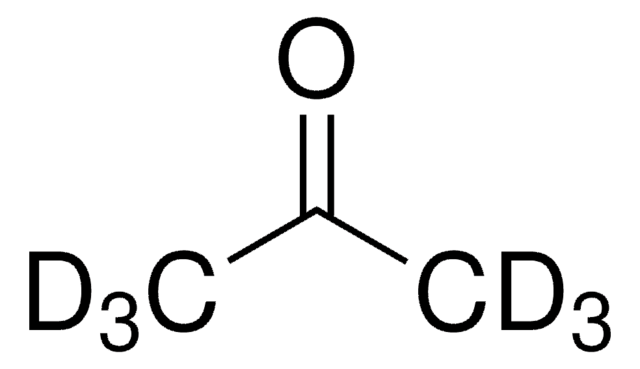209686
Iridium
powder, 99.9% trace metals basis
Iniciar sesiónpara Ver la Fijación de precios por contrato y de la organización
About This Item
Fórmula empírica (notación de Hill):
Ir
Número de CAS:
Peso molecular:
192.22
Número CE:
Número MDL:
Código UNSPSC:
12141720
ID de la sustancia en PubChem:
NACRES:
NA.23
Productos recomendados
Ensayo
99.9% trace metals basis
Formulario
powder
resistividad
4.71 μΩ-cm
bp
4130 °C (lit.)
mp
2450 °C (lit.)
densidad
22.65 g/cm3 (lit.)
cadena SMILES
[Ir]
InChI
1S/Ir
Clave InChI
GKOZUEZYRPOHIO-UHFFFAOYSA-N
¿Está buscando productos similares? Visita Guía de comparación de productos
Categorías relacionadas
Descripción general
Iridium is a rare and dense transition metal that belongs to the platinum group of metals and is known for its remarkable physical and chemical properties. Iridium is used in high-temperature applications such as crucibles for crystal growth and in devices that operate under extreme conditions due to its high melting point and stability at elevated temperatures. It is also used in electrical contacts and electrodes because of its excellent corrosion resistance and electrical conductivity. In addition, iridium is used as a catalyst in various organic reactions including hydrogenation, water splitting, C-C coupling, and olefin metathesis.
Aplicación
- Iridium-based double perovskites for efficient water oxidation in acid media: This study highlights the development of iridium-based double perovskites that reduce iridium content while maintaining high activity and stability for water oxidation, significant for energy-related applications in material science (Diaz-Morales et al., 2016).
- Recent advances in understanding oxygen evolution reaction mechanisms over iridium oxide: This paper provides insights into the oxygen evolution reaction (OER) mechanisms on iridium oxide, crucial for improving catalytic processes in industrial applications (Naito et al., 2021).
- Iridium oxide fabrication and application: A review: A comprehensive review that discusses various methods for the fabrication of iridium oxides and their applications, particularly in sensors and catalysts, relevant to both drug discovery and material science (Chen et al., 2020).
Palabra de señalización
Danger
Frases de peligro
Consejos de prudencia
Clasificaciones de peligro
Flam. Sol. 1
Código de clase de almacenamiento
4.1B - Flammable solid hazardous materials
Clase de riesgo para el agua (WGK)
nwg
Punto de inflamabilidad (°F)
Not applicable
Punto de inflamabilidad (°C)
Not applicable
Equipo de protección personal
Eyeshields, Gloves, type P3 (EN 143) respirator cartridges
Elija entre una de las versiones más recientes:
¿Ya tiene este producto?
Encuentre la documentación para los productos que ha comprado recientemente en la Biblioteca de documentos.
Los clientes también vieron
Chun-I Lee et al.
Journal of the American Chemical Society, 135(9), 3560-3566 (2013-02-05)
Compounds with carbon-boron bonds are versatile intermediates for building more complex molecules via the elaboration of the carbon-boron bonds into other carbon-element bonds. The synthesis of carbon-boron bonds by catalytic dehydrogenative borylation of carbon-hydrogen bonds with dialkoxyboranes (RO)2BH is particularly
Daniel Shiu-Hin Chan et al.
PloS one, 8(3), e60114-e60114 (2013-03-28)
We report herein a novel luminescent iridium(III) complex with two hydrophobic carbon chains as a non-reaction based chemosensor for the detection of Hg(2+) ions in aqueous solution (<0.002% of organic solvent attributed to the probe solution). Upon the addition of
Yuyang Zhou et al.
Chemical communications (Cambridge, England), 49(31), 3230-3232 (2013-03-14)
Five iridium(III) complexes with two N-heterocyclic carbene (NHC) ligands and an ancillary ligand have been designed and successfully synthesized. With multicolor photoluminescence and low toxicity, these carbene complexes were tested, for the first time, as living cell imaging reagents and
Matthew R Kelley et al.
Inorganic chemistry, 52(5), 2564-2580 (2013-02-21)
A series of seven [Ir{ArNC(NR2)NAr}(cod)] complexes (1a-1g; where R = Me or Et; Ar = Ph, 4-MeC6H4, 4-MeOC6H4, 2,6-Me2C6H3, or 2,6-(i)Pr2C6H3; and cod = 1,5-cyclooctadiene) were synthesized by two different methods from the neutral guanidines, ArN═C(NR2)NHAr, using either MeLi and
Shiguang Pan et al.
Organic letters, 15(8), 1902-1905 (2013-04-02)
A cationic Ir(I) complex-catalyzed O-to-N-alkyl migration in 2-alkoxypyridines bearing a secondary alkyl group on the oxygen atom by C-O bond cleavage is described. The present transformation gave various N-alkylpyridones in moderate to good yields. The addition of sodium acetate played
Nuestro equipo de científicos tiene experiencia en todas las áreas de investigación: Ciencias de la vida, Ciencia de los materiales, Síntesis química, Cromatografía, Analítica y muchas otras.
Póngase en contacto con el Servicio técnico











